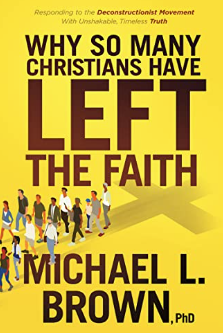Get it Straight: Jesus Is Not Black or White
While attending college in 1973-1977, it was always a joy to meet other, on-fire Christians, since I was studying at a secular university rather than a Christian school. One of these fellow-believers was a Black Christian named James. He, too, was deeply devoted to the Lord, so we would fellowship with one another whenever we could.
He often spoke about his congregation in Brooklyn, so one day, together with some friends (all of us white Christians), we attended one of the services.
It was a terrific meeting, with great singing and preaching and a real atmosphere of faith. As for the makeup of the congregation, it was virtually all Black (with the exception, in this case, of my friends and I). That’s what also made it special for me, since this was a fairly new cultural experience, and it was spiritually vibrant. I felt very much at home.
What struck me as odd, though, was a large mural on one of the walls, depicting Jesus and His apostles as Black. Everyone knew they were white (or so, I assumed, without any real thought).
When I asked him about the mural, out of curiosity, not accusation, he said to me, “When you get your high school yearbook, what’s the first thing you do? You look for your own picture. It’s the same thing here. We’re not saying that Jesus and the apostles were Black. It’s simply a way for people to find a point of identification with Him.”
That was all I needed to hear, and I subsequently attended another service there, along with a major rally in Manhattan.
What I didn’t realize until later was that the depictions of Jesus I was used to, be it in movies or portraits, were equally anachronistic—perhaps even more so—presenting Jesus as a white, European Christian rather than as a first-century Jewish rabbi.
To be sure, some of these depictions contain an inherent antisemitism, most dramatically illustrated in the famous “Christ among the Doctors” by Albrecht Dürer, where Jesus, a beautiful man, is contrasted with the Jewish scholars, some of whom look demonic—literally.
Prof. Bernard Starr has written about this anti-Semitic strain in Christian art, both in article form and full-length book form. See, for example, his 2015 article, “Five Stages of Anti-Semitism in Art — From Medieval to Modern Times,” along with his 2016 book, “Jesus, Jews, And Anti-Semitism In Art: How Renaissance Art Erased Jesus’ Jewish Identity & How Today’s Artists Are Restoring It.”
But my focus here is not on these anti-Semitic depictions. It is on the way in which we create a Jesus in our image. This can be as negative as it is positive.
On the positive side, all of us can find that place of identification in Jesus, as with the church I visited in Brooklyn (with its Black Jesus) and as with classic movies about the Lord (with their white Jesus). We can relate to this Jesus because He is just like us—not just a human being, which is the great point of the Incarnation, but also someone we can relate to culturally.
That’s why it’s no surprise to see religious iconography in which Jesus looks like the people who worship Him, be they Black or White or Chinese or Native American. This trend continues in depictions of other biblical characters, as well, from Moses to Mary. (For the purpose of this article, I’m not discussing the larger question of religious iconography and whether it is right to portray Jesus at all.)
On the negative side, when our image of Jesus drives others away, since He is not like them and they are not like Him, this can be very destructive. This is all the more true when the outsider Christians are not only presenting a foreign Jesus, but when they themselves are poor examples of the faith. Who needs that Jesus?
In his thunderous 1970 book, “How Black Is the Gospel? A Decisive and Truthful Message for Today’s Revolution,” Evangelist Tom Skinner wrote, “Many black Americans bitterly denounce Christianity and the Bible because, in their view, those who practice religious piety are among the leading exponents of hate, bigotry and prejudice. They feel that these ‘Bible-toting Saints’ perpetuate the most segregated hour of the week-eleven o’clock Sunday morning.”
But that was just the start (and remember, he wrote this in 1970).
He continued, “Today’s young blacks, having learned more history than their forebears, are quick to resent acts of so-called Christianity and the use of those random Biblical verses that are so blatantly detrimental to the dignity of the black man in America.”
Then, with great insight, he wrote, “There must have been thousands of slaves who vowed when they learned to read that they would never look at or allow their children to see those passages of St. Paul, which encourage servants to be obedient to their masters. In many instances, these were the only portions of the Bible that ‘ole massa’ would allow the preacher to read to illiterate black men, in the hope that obedience to the Scriptures would further secure the system of white supremacy. This spirit still lives.”
As for the white man’s depiction of Jesus, Skinner said, “Black America is not about to follow a white Christ. The image of a Christ patterned after [Warner] Sallman’s portrait is more than suspect. It has become a contemptuous symbol to the black man of all the fakery and chicanery endorsed by so many white Christians. If Christ takes on the image of an Anglo-Saxon Protestant suburbanite, He’s obviously not for black men. It is inconceivable that this kind of Christ would die for black people.”
This was true in 1970, and it remains true today. Perhaps Skinner’s words have opened some of our eyes?
Skinner then wrote this: “The question is, of course, whether this view of Jesus Christ is true. Has Christianity become the ‘worship of white’ used as a tool of oppression to increase the black man’s burden? If this be true, it is understandable that the black man must find his salvation through worshiping black.”
This is exactly what has happened with radical race-based cults like the Hebrew Israelites. They have reacted against a white Jesus and a whitewashed Bible, which, in their view, are an essential part of the oppressive system of white supremacy, and they have created a Jesus in their own image—not just Black, but militantly anti-white.
But Skinner did not end there. He said, “One thing is certain: whatever contemporary man decides about the ‘color’ of religion, Christ stands outside that debate. Even a superficial reading of the gospel reveals that Christ showed only one, special interest—allegiance to His Father and the Kingdom of God. He was owned by no man, He belonged to no particular group, and He refused to sanction one party or system over another. He was God in the form of man – neither black nor white.” (Skinner also pointed out, quite rightly, that, “Racism as we know it today was not an issue in Biblical times.” The conflicts were over ethnicity, culture and religion, not race.)
Of course, Jesus came into this world as a Jew named Yeshua, and His mission began with a focus on His own people Israel. But His purpose in coming into the world as the Jewish Messiah was to die for Jew and Gentile alike and to gather believing Jews and Gentiles into one spiritual family without class or caste distinctions.
 And while we can speculate on what, exactly, Jesus looked like, that is really a secondary issue.
And while we can speculate on what, exactly, Jesus looked like, that is really a secondary issue.
What we must take hold of is that He transcends Blackness or whiteness (or any ethnicity or color), which is why Skinner then wrote this: “All right, granted that Jesus Christ was neither black nor white, Protestant nor Catholic, and did not embrace Christianity as a system. But if Christ was essentially concerned with the spiritual condition of man, how can He relate to the issues of today? How can He respond to the political, economic and social needs of [a] Black American?”
Those are the questions we need to ask (for Black and white Americans and for all people of all nations), and that’s where our focus needs to be. Jesus transcends our earthly barriers and norms and smashes our prejudices. Let us follow that Jesus and present Him to the world.{eoa}
Join Charisma Magazine Online to follow everything the Holy Spirit is doing around the world!




























































